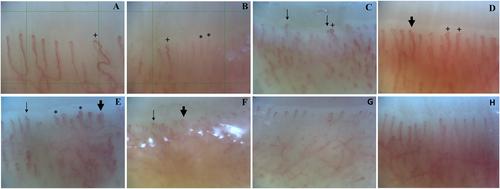Chronic spontaneous urticaria: Evidence of systemic microcirculatory changes
Abstract
Background
Chronic spontaneous urticaria (CSU) is a chronic inflammatory skin disease where activation of endothelial cells (ECs) at sites of skin lesions leads to increased blood flow, leakage of fluid into the skin, cellular infiltration, and vascular remodeling. To understand the disease duration and the sometimes vague systemic symptoms accompanying flares, the objective of this study was to examine if CSU comes with systemic vascular changes at the microcirculatory level.
Methods
We investigated CSU patients (n = 49) and healthy controls (HCs, n = 44) for microcirculatory differences by nailfold videocapillaroscopy (NVC) and for blood levels of the soluble EC biomarkers serum vascular endothelial growth factor (VEGF), soluble E-selectin, and stem cell factor (SCF). Patients were also assessed for clinical characteristics, disease activity, and markers of autoimmune CSU (aiCSU).
Results
CSU patients had significantly lower capillary density, more capillary malformations, and more irregular capillary dilations than HCs on NVC. Serum levels of VEGF, soluble E selectin and SCF were similar in CSU patients and HCs. CSU patients with higher VEGF levels had significantly more abnormal capillaries. Patients with markers of aiCSU, that is, low IgE levels or increased anti-TPO levels, had significantly more capillaries and less capillary dilations than those without.
Conclusion
Our results suggest that CSU comes with systemic microcirculatory changes, which may be driven, in part, by VEGF.


 求助内容:
求助内容: 应助结果提醒方式:
应助结果提醒方式:


